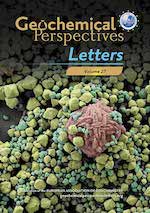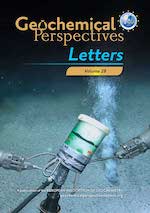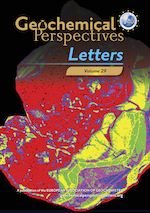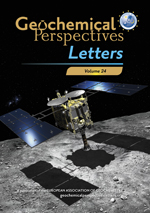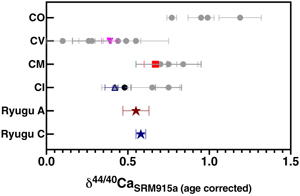 | The Solar System calcium isotopic composition inferred from Ryugu samples Abstract: The Hayabusa2 spacecraft has returned samples from the Cb-type asteroid (162173) Ryugu to Earth. Previous petrological and chemical analyses support a close link between Ryugu and CI chondrites that are presumed to be chemically the most primitive meteorites with a solar-like composition. However, Ryugu samples are highly enriched in Ca compared to typical CI chondrites. To identify the cause of this discrepancy, here we report stable Ca isotopic data (expressed as δ44/40CaSRM915a) for returned Ryugu samples collected from two sites. We found that samples from both sites have similar δ44/40CaSRM915a (0.58 ± 0.03 ‰ and 0.55 ± 0.08 ‰, 2 s.d.) that fall within the range defined by CIs. This isotopic similarity suggests that the Ca budget of CIs and Ryugu samples is dominated by carbonates, and the variably higher Ca contents in Ryugu samples are due to the abundant carbonates. Precipitation of carbonates on Ryugu likely coincided with a major episode of aqueous activity dated to have occurred ∼5 Myr after Solar System formation. Based on the pristine Ryugu samples, the average δ44/40CaSRM915a of the Solar System is defined to be 0.57 ± 0.04 ‰ (2 s.d.). |
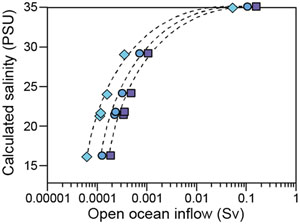 | Quantifying seawater exchange rates in the Eocene Arctic Basin using osmium isotopes Abstract: The closure of seaways that connected the Arctic Ocean to the global ocean during the early Paleogene led to severe hydrographic restriction. We present new osmium isotope data from organic-rich sediments deposited in the central Arctic Ocean during the Early–Middle Eocene. The new data show that the long term isotopic composition of osmium in Arctic seawater began to diverge from that of the global ocean at ∼54 Ma, after the Eocene Thermal Maximum 2 hyperthermal event. This divergence was probably caused by the gradual closure of seaways connecting the Arctic Ocean to the global ocean. The Os data are used to calculate water exchange rates between the Arctic and surrounding oceans and to calculate Arctic Ocean salinity during the Early Eocene. The results show that the development of severe, long term Arctic Basin restriction after ∼54 Ma occurred as open ocean seawater input decreased below ∼0.01 Sv, resulting in a mean basin salinity between 8–16 PSU, depending on model assumptions. |
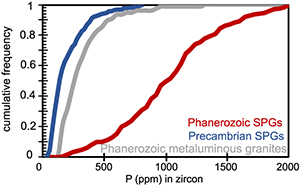 | Secular variability in zircon phosphorus concentrations prevents simple petrogenetic classification Abstract: Phosphorus (P) concentrations in zircon have been used to discriminate their derivation from metaluminous versus strongly peraluminous granites (SPGs) based on the empirical observation of lower P concentrations in zircon from Phanerozoic metaluminous versus peraluminous granites. Higher P concentrations in zircon from Phanerozoic SPGs reflect enhanced apatite solubility in peraluminous melts and overall higher P concentrations in peraluminous granites. However, SPGs derived from partial melting of Precambrian sedimentary rocks have lower P concentrations compared to Phanerozoic metaluminous granites, reflecting lower P concentrations in Precambrian versus Phanerozoic sedimentary sources. We demonstrate that zircons from Precambrian SPGs also have lower P concentrations compared to Phanerozoic counterparts, likely reflecting lower P concentrations in their parental melts. Applying the P-in-zircon proxy to the detrital zircon record does not effectively discriminate between metaluminous and peraluminous sources and underestimates contributions from peraluminous granites. Although detrital zircons are an important early Earth archive, a uniformitarian perspective cannot always be applied when using trace element proxies developed on Phanerozoic samples. |
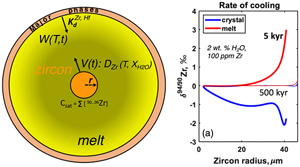 | The rises and falls of zirconium isotopes during zircon crystallisation Abstract: Zircon trace element and isotopic analysis for an increasing number of isotopic systems provide valuable insights into magma crystallisation, and evolution of the continental crust. Zirconium stable isotopes have been measured recently and shown to vary by several per mille on Earth. Both positive and negative shifts of δ94/90Zr have been found in zircons and melts, and equilibrium isotopic fractionations are found to be small. We here employ and further develop a zircon crystallisation programme with two moving boundaries targeting zircon crystallisation in the presence of other minerals. We reproduce positive, negative, and inverse δ94/90Zr, Zr/Hf, and other compatible trace element variations in zircon and surrounding melt that can be entirely explained by the boundary layer processes during kinetics of zircon crystallisation in a realistic set of geologic conditions. Progressively lower δ94/90Zr values in zircon develop during rapid crystallisation, lower melt water contents, crystallisation in the lower temperature range, and whilst co-crystallising with the Zr-poor phase. Given large (multi-per mille) kinetic Zr isotope fractionations discovered, zircon may serve as a monitor of magmatic crystallisation conditions, but is unlikely to serve as a diagnostic tool for the bigger set of petrological problems (e.g., evolution of the continental crust) without proper context. |
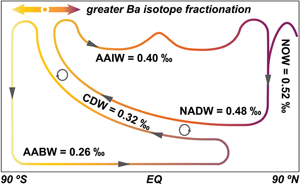 | High latitude controls on dissolved barium isotope distributions in the global ocean Abstract: The high latitude regions play a key role in regulating the marine biogeochemical cycling of barium (Ba) and the pre-formed Ba isotope compositions in the global ocean. In this study, we present 17 new depth profiles of dissolved Ba concentrations ([Ba]) and isotope compositions (δ138Ba) from the high latitude Atlantic, Pacific and Southern Oceans to trace the ventilation of deep waters in the Southern Ocean and their subsequent transport throughout the global ocean. Our data reveal how biogeochemical processes in the Southern Ocean generate distinct δ138Ba signatures of upper ocean water masses, and that large scale ocean circulation constrains the meridional gradient of δ138Ba distributions in the deep Atlantic Ocean. The significant increase in [Ba] of deep waters in the North Pacific is mainly achieved through dissolution of sinking particles which adds a δ138Ba signal comparable to the deep Pacific Ocean. |
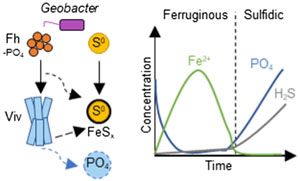 | Co-reduction of Fe(III) and S0 drives Fe-S biomineral formation and phosphate mobilisation Abstract: Microbially mediated iron and sulfur cycling have impacted redox transitions and the bioavailability of nutrients throughout Earth’s history. Here, we incubated Geobacter sulfurreducens in the co-presence of ferrihydrite and S0 at pH 6.5, 7.2 or 8.0. Microbial reduction of Fe(III) and S0 resulted in a shift from ferruginous (Fe2+-rich) to sulfidic (sulfide-rich) conditions and the precipitation of mackinawite, greigite and vivianite. The initial pH controlled the timing of the ferruginous-sulfidic transition and the relative abundance and crystallinity of the formed minerals. Vivianite formation was attributed to phosphate initially added to the medium. Phosphate showed a dynamic cycle, with low dissolved concentrations initially due to sorption to ferrihydrite, followed by vivianite precipitation under ferruginous conditions, and a significant release under sulfidic conditions. Co-reduction of Fe(III) and S0 therefore regulates Fe-S biomineral formation and P bioavailability, which could be particularly important to consider in microbial mats and the sulfate-poor Archean ocean. |
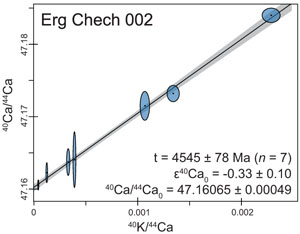 | K-Ca dating and Ca isotope composition of the oldest Solar System lava, Erg Chech 002 Abstract: Erg Chech 002 (EC 002) is an andesitic meteorite, which is the oldest lava in the Solar System as determined by the 26Al-26Mg relative chronometer. Here, we present high precision Ca isotope data for the bulk rock and mineral separates of EC 002, and for the first time, obtain a 40K-40Ca isochron by using the Nu Sapphire, a collision cell equipped MC-ICP-MS instrument. The mineral separates yield a 40K-40Ca age of 4545 ± 78 Ma with an initial 40Ca/44Ca = 47.16065 ± 0.00049 (ɛ40CaSRM 915a = −0.33 ± 0.10). The age is identical with those obtained from other long lived isotopic systematics but more precise, and it is consistent with the short lived 26Al-26Mg age. The δ44/40Ca of EC 002 is 0.87 ± 0.05 ‰ suggesting that EC 002 might represent a differentiated melt from an ordinary chondritic parent body. The extremely old age of EC 002, along with the similar ɛ40Ca values among most meteorites, suggests that the 40Ca was homogeneously distributed within early formed planetesimals and the ɛ40Ca value of EC 002 could represent the average of initial ɛ40Ca of the Solar System. |
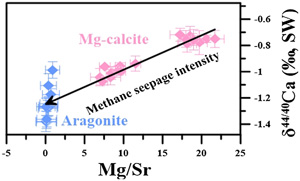 | A dual role of methane seepage intensity on calcium isotopic fractionation Abstract: Calcium isotopes are an important indicator to study the global calcium cycle, however the controls on calcium isotopic fractionation in marine carbonates are still under debate. Seep carbonates are widely precipitated on the continental margins. Constraining the calcium isotopic fractionation mechanism operating during the precipitation of seep carbonates is important for understanding the global calcium cycle. In this paper, we report the calcium isotopic composition of authigenic carbonates recovered from seep sites in the South China Sea, and discuss how the methane seepage intensity controls the calcium isotopic fractionation. The result shows that the calcium isotopic composition of the aragonite (−1.17 ‰ SW) is lower than that of the calcite (−0.79 ‰ SW). Compared to calcite, aragonite is usually formed in the near-seafloor environment (or close to the sediment-seawater interface) with a higher precipitation rate, both of which indicate high methane seepage intensity. Therefore, we propose that methane seepage intensity is the fundamental factor in controlling the calcium isotopic fractionation of the seep carbonates. The calcium isotopic composition of the seep carbonates could be used as an important proxy to reconstruct the palaeo cold seep activities and to better constrain the calcium cycling. |
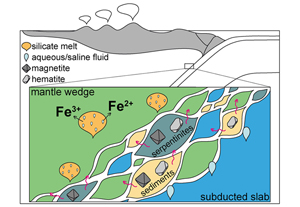 | Preferential mobilisation of oxidised iron by slab-derived hydrous silicate melts Abstract: The role of slab-derived hydrous silicate melts in the transfer of the oxidised signature in subduction zones remains poorly constrained. We have investigated the mobility and redox state of iron in hydrous silicate melts by carrying out solubility measurements of hematite–magnetite assemblages in a piston-cylinder apparatus combined with electron microprobe and Mössbauer analysis of the recovered glasses. The experiments were performed at subcritical conditions, i.e. two-fluid phases coexisting with the solid assemblage. We observe concentrations of total FeO as high as 1.85 ± 0.18 wt. % (2.07 ± 0.41 wt. % in saline systems) at 2 GPa and 900 °C, with Fe3+/Fetot ratios of 0.79 ± 0.04 (0.45 ± 0.07) that indicate the dominance of oxidised iron in the melt phase. Combined with thermodynamic modelling to reconstruct the composition and speciation of the coexisting fluid phase, we demonstrate that hydrous silicate melts can transport 20 times more dissolved iron, preferentially as oxidised iron, than aqueous fluids at sub-arc conditions. Our results support the efficient dissolution of ‘fluid-insoluble’ iron oxides in slab-melts, which are thus efficient agents for the transfer of oxidised iron to the mantle wedge, ultimately contributing to the oxidation of the arc magma source. |
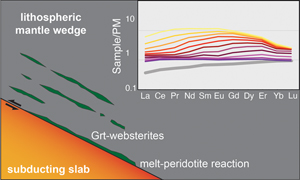 | Geochemical evolution of melt/peridotite interaction at high pressure in subduction zones Abstract: The Borgo outcrop of the Monte Duria Area (Adula-Cima Lunga unit, Central Alps, Italy) is an excellent example of melt-peridotite interaction which occurred under a deformation regime at high pressure, that enabled the combination of porous and focused flow of eclogite-derived melts into garnet peridotites. Migmatised eclogites are in direct contact with retrogressed garnet peridotites and the contact is marked by a tremolitite layer, also occurring as boudins parallel to the garnet layering in the peridotites, derived from a garnet websterite precursor produced by the interaction between eclogite-derived melts with the peridotite at high pressure. LREE concentrations of tremolitite along a 120 m length profile, starting from the eclogite-peridotite contact to the inner part of the peridotite, show a progressive enrichment coupled with a peculiar fractionation. Numerical modelling assuming the eclogitic leucosome as the starting percolating melt reproduces the REE enrichment and LREE/HREE fractionation observed in tremolitite bulk rocks within the first 30 m. The comparison between the REE composition of the retrogressed garnet websterites along the profile and the result of our model suggests that reactive melt infiltration at high pressure is a plausible mechanism to modify the REE budget of mantle peridotites that lie on top of the subducting crustal slab. |
<< Previous issueNext issue >>


